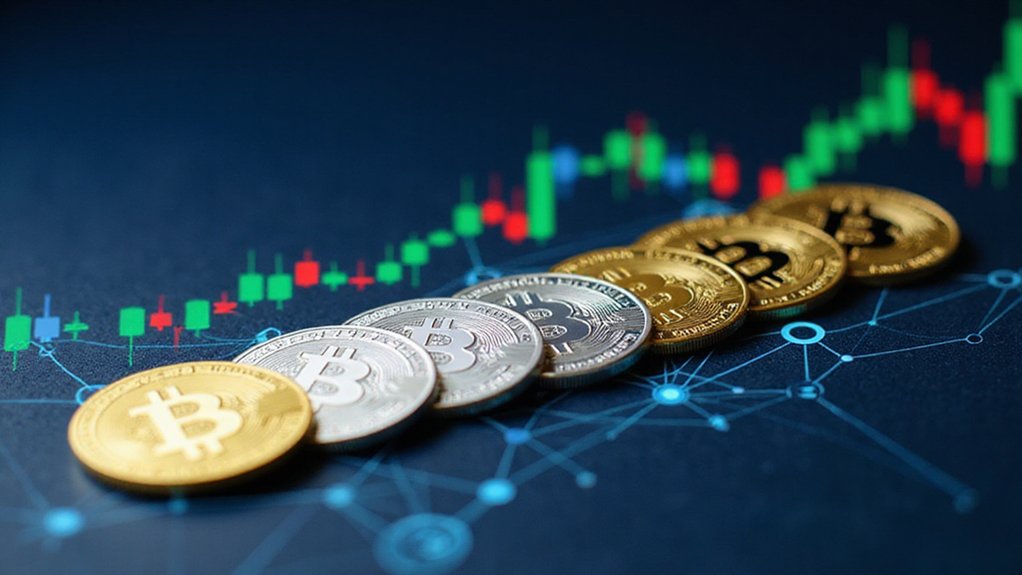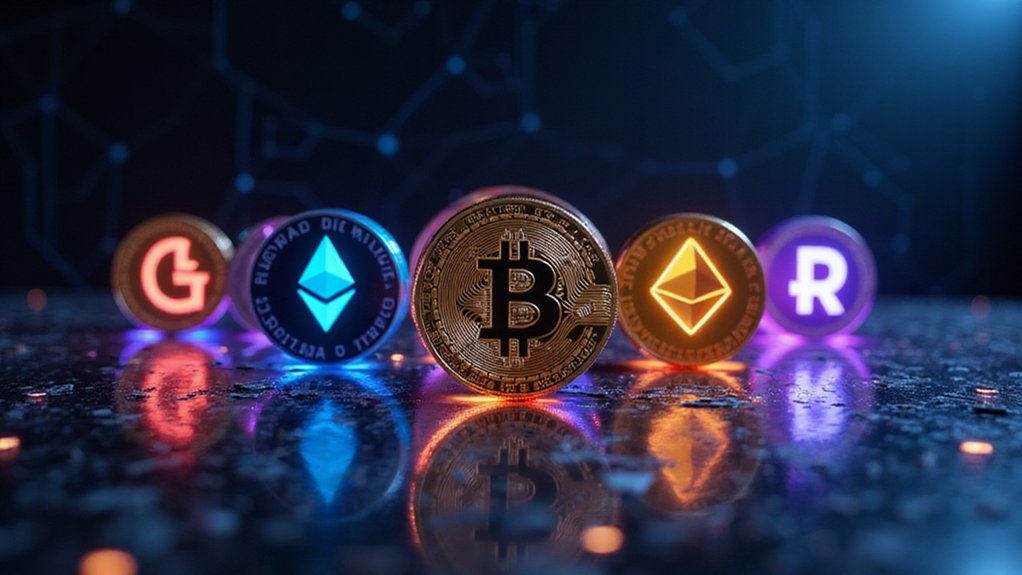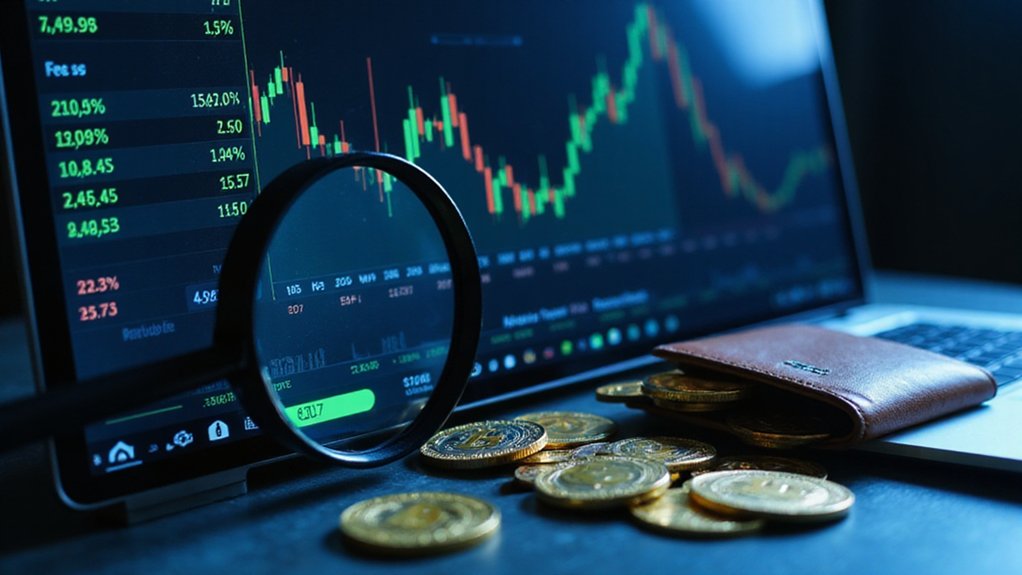Emerging cryptocurrency gems warrant attention beyond the Bitcoin-Ethereum hegemony. Security-focused protocols like Vultisig (VULT) and Sophon (SOPH) position advantageously for institutional capital, while Mantra (OM) and XRP boast impressive YTD returns exceeding 90% and 300% respectively. The real-world asset tokenization space sees Symbiotic, GM Network, and Karak gaining traction, while meme coins Floki and Dogwifhat demonstrate remarkable volatility. The intersection of pragmatic security innovations with community-driven markets creates fascinating investment dichotomies worth exploring.

Where does one begin when traversing the increasingly labyrinthine ecosystem of digital assets that seems to expand exponentially with each passing quarter?
The 2025 cryptocurrency landscape offers a veritable smorgasbord of nascent projects vying for investor attention amid established juggernauts like Bitcoin and Ethereum (which, unsurprisingly, maintain their hegemonic positions in market capitalization).
Among the neophytes worthy of consideration, Vultisig (VULT) and Sophon (SOPH) have emerged as security-focused contenders in an industry perpetually plagued by vulnerabilities.
Their emphasis on blockchain security protocols—a surprisingly pragmatic approach in a space often enamored with theoretical use cases—positions them advantageously as institutional capital continues its cautious migration into digital assets.
The NFT marketplace disruptor Opensea (SEA) merits scrutiny for its ambitious attempt to decentralize a sector ironically centralized despite its blockchain underpinnings.
Its trajectory may prove instructive for those monitoring the evolution of digital ownership paradigms beyond mere speculation.
Meanwhile, ZORA, Vanilla Finance, and THORWallet (TITN) have cultivated niche ecosystems within the broader DeFi universe, each addressing friction points that have historically impeded mainstream adoption.
Projects targeting real-world asset tokenization—Symbiotic, GM Network, and Karak—represent the bridge between traditional finance and its distributed successor, potentially unleashing liquidity for previously illiquid assets (a proposition whose value cannot be overstated in capital-constrained environments).
For the contrarians among us, the memecoin sector offers Floki (FLOKI) and Dogwifhat (WIF), whose price projections ($0.000101-$0.000333 and $0.44-$2.80 respectively) reflect their community-driven volatility rather than fundamental utility. The market’s unprecedented volatility in 2025 echoes the recent performance of top cryptocurrencies like Mantra (OM), which achieved an astonishing 92.71% YTD return.
XRP has demonstrated remarkable growth potential with its 327% YTD performance, positioning it as one of the strongest performers among established altcoins.
Their inclusion in diversified portfolios remains a matter of risk tolerance rather than investment thesis.
LI.FI’s liquidity aggregation framework and Lens’s decentralized social media infrastructure round out the roster of notable entrants, each addressing infrastructural deficiencies that have hampered cryptocurrency’s shift from speculative vehicle to functional economic layer.
Solana has gained significant traction among investors due to its transaction speeds that outpace many competitors in the blockchain space.
Frequently Asked Questions
How Risky Are Investments in New Cryptocurrencies?
Investments in new cryptocurrencies represent the financial equivalent of walking blindfolded through a minefield.
Their extreme volatility, absence of historical performance data, vulnerability to pump-and-dump schemes, and regulatory uncertainty create a perfect storm of risk factors.
While potentially offering astronomical returns (the siren song that lures the optimistic), most nascent crypto assets ultimately collapse, leaving investors holding worthless digital tokens.
Even seasoned investors find themselves outmaneuvered in this speculative arena where FOMO frequently trumps fundamental analysis.
What’s the Minimum Investment Needed for Cryptocurrency Trading?
Cryptocurrency trading requires surprisingly modest capital to begin—as little as $1-10 on major retail exchanges like Coinbase or Binance.
Professional investment vehicles, however, demand substantially higher entry points (often $250,000+).
While microtransactions are technically feasible, their practicality diminishes under the weight of fees and spreads that disproportionately affect smaller trades.
The true minimum, thus, exists in that nebulous territory between what platforms permit and what economic efficiency dictates as rational.
Are These New Cryptocurrencies Available on All Trading Platforms?
No, new cryptocurrencies aren’t universally available across all trading platforms.
Their distribution follows a predictable hierarchy: many debut on decentralized exchanges (DEXs) before earning centralized exchange (CEX) listings.
Regulatory hurdles, technical requirements, and liquidity thresholds create significant gatekeeping.
Exchange-specific relationships and strategic partnerships further fragment availability.
The most successful tokens eventually achieve widespread listing, while niche projects may remain confined to specific ecosystems—a reality that occasionally frustrates traders seeking early-stage opportunities.
How Are Cryptocurrency Gains Taxed in Different Countries?
Cryptocurrency taxation varies wildly across jurisdictions, with a global patchwork that would make even the most dedicated tax attorney sigh.
The UK and Australia treat crypto as property (subject to CGT), while Japan imposes eye-watering progressive rates up to 55% as “miscellaneous income.”
Those seeking relief might eye Germany (tax-free after one year), Portugal (historically tax-free), or Singapore (no capital gains tax)—though such havens are becoming increasingly rare as regulators worldwide sharpen their pencils.
What Security Measures Protect Investments in Newer Cryptocurrencies?
Newer cryptocurrencies demand heightened vigilance, as their nascent infrastructures often harbor undiscovered vulnerabilities.
Prudent investors employ multi-layered security: hardware wallets (physically sequestering assets from online threats), rigorous due diligence on project audits, and implementing robust 2FA protocols.
Smart contract audits—often overlooked in the rush to market—represent a critical safeguard against code exploitation.
The paradox remains that many enthusiasts who meticulously secure traditional assets will, inexplicably, entrust substantial capital to unproven blockchain projects.









